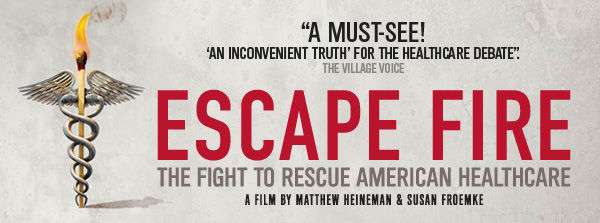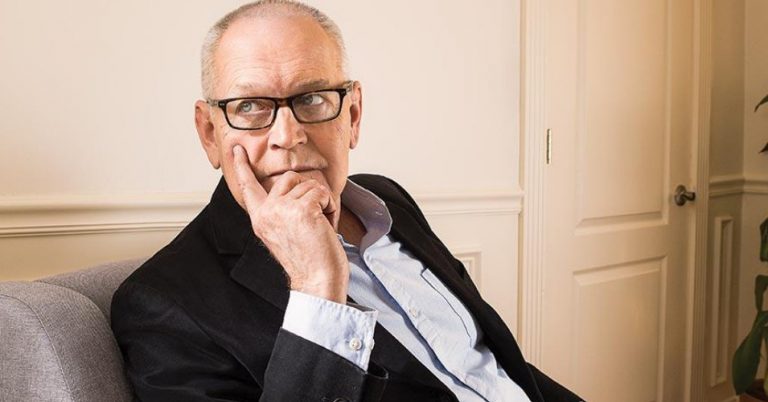Escape Fire — The Fight to Rescue America’s Healthcare
I encourage you to watch the “Must See” documentary, “Escape Fire — The Fight to Rescue America’s Healthcare” (trailer below). It won several awards at the Sundance Film Festival, and was described as “An Inconvenient Truth for the healthcare debate” (The Village Voice). Over two million people watched when it aired for free on CNN. Since then it has been available in theaters and for paid download, and the Institute for Healthcare Improvement helped to bring free screenings of the film to over 60 colleges and universities across the country.
MY ESCAPE FIRE: I believe the key to health reform is to Get The Healthcare Incentives Right. Where private companies measure success in business terms (revenue, profit, ROI, payback period, stock price, etc.), public entities measure success differently and over longer time periods. My hybrid proposal blends the two: a public sector model of wellness & basic care (doctors & nurses work as government employees) but exploiting capitalism and encouraging innovation & risk taking.
Official Trailer
Watch the full 1.5 hour version on Netflix or YouTube ($3.99).
4:00 Minute Teaser Video
UPDATE: “In 2010, the US spent $2.5 trillion on healthcare.” But now (in 2018) we are spending $3.65 trillion/year. With a whole new way of looking at healthcare, we could improve longevity and outcomes while cutting costs in half to match what other advanced nations pay. Doing that would save over $1.5 trillion every year.
Escape Fire Stats & Quotes …
- “We’re in the grip of a very big industry, and it doesn’t want to stop making money.”
- $1.1 billion was spent on healthcare lobbying between 2009 & 2010.
- The US spent $2.7 trillion on healthcare in 2011, more than any other wealthy nation, but we have worse outcomes.
- The average American hospital visit costs $1,666 per day, which is four times more than in the rest of the world.
- The average cost of a drug-eluding stent procedure is $40,000, while the average cost of one session of cardiac rehab is just $100.
- A doctor who spends 5 min to install a stent in a clogged artery may earn $1,500, but if she spent 45 min talking with the patient about how to avoid such conditions, she’d only earn about $15.
- Our average lifespan is ranked 50th among OECD nations.
- Only 1 in 16,000 Americans per year have had their lives saved or extended by advances in healthcare technology.
- It’s not just the health of grandma at stake, or even the health of the healthcare system; it’s also the very health of the nation.
- The cost of American healthcare is rising so fast that it is projected to reach $4.2 trillion (~20% of GDP) within six years.
- The average per capita cost of healthcare in the developed world is about $3,000 a year, while the average in the US is about $8,000 annually. Who pays for that? We all pay, and it comes from funds that could be better used elsewhere.
- 75% of healthcare costs go to treating chronic diseases that are largely preventable.
- The industry sees More as better, and provides more, because that’s how it makes money. We pay hospitals to be full, so they try to be full. We pay doctors to see patients, so they try to see lots of patients.
- Fee-for-Service rewards physicians for doing more, not for providing better care or eliminating the need.
- Primary care physicians earn about half as much as specialists.
- Our Disease-care system doesn’t want you to die, but it doesn’t really want you to get well either. It wants you to keep coming back as a paying customer for treatment of your chronic illness. In fact, many public policies, including those affecting the food supply and the environment, actually increase disease.
- We spend $300 billion a year on pharmaceuticals, which is almost as much as the rest of the world combined. And we take 10 times more meds now than in the 1950’s.
- Half of network TV ads now are for various drugs. The only other country that allows consumer drug ads is New Zealand. The ads always end with the same phrase, “Ask your doctor.” People do, and the docs comply.
- People eat what’s cheap and what’s available, but the bigger cost comes from treating the result of eating cheap (and unhealthy) food. If trends continue through 2020, 20% of healthcare spending, or up to $1 trillion, will be spent on obesity related conditions.
- Almost 40% of US hospitals offer fast food restaurants on their premises.
- Insurance companies have been able to increase premiums at will, and since 1999 the cost of employer-sponsored insurance premiums has increased four times faster than salaries. If other prices had grown as quickly as healthcare costs since 1945, a dozen eggs would cost $55, a gallon of milk would cost $48, and a dozen oranges would cost $134.
- “Medicine used to be about healing, but when it became a business, we lost our moral compass, and it became about profit.”
- In July 2012, GSK (GlaxoSmithKline) agreed to plead guilty for failing to disclose safety data on Avandia, the world’s most popular diabetes drug, as part of a $3 billion settlement. The federal lawsuit was filed after the drug was linked to heart risks, and prosecutors said the company had paid doctors and manipulated medical research to promote the drug. But the settlement amount is less than the annual revenue from the drug, a slap on the hand or an acceptable cost of doing business, and no one went to jail.
Click here for my extensive list of other healthcare stats.
Click here for a copy of the Frisco Lakes discussion document from 1/15/2017, where I taught a Lifelong Learning class on Moore’s Law and The Future of Healthcare.
Click here for a list of other important videos about the future of healthcare.





I started Modern Health Talk in 2011 as a way to help seniors age safely and gracefully in their own home, avoiding institutional care or nursing homes, which are far more expensive.
I’ve learned since that fixing healthcare is difficult and requires also addressing our politics and the corrupting influence of wealthy special interests. That’s why my efforts have shifted towards (1) healthcare public policy and (2) future tech innovations that can disrupt existing business models.
From Why American Healthcare is So Expensive, “For over eight years the Republican Congress tried and failed to repeal Obama’s Affordable Care and Patient Protection Act (ACA) and replace it with something better. Each attempt was along party lines with bills crafted in secret and without public hearings, debate or testimony from stakeholders with different perspectives. … A true fix would … improve care delivery and reduce the need for care in the first place through wellness, but that was never part of their plans. … It [healthcare] must be approached systemically and address divisive politics.”
This more recent article lists and discusses some of the many factors making our $3.5 trillion/year healthcare system nearly twice as expensive as that found in other advanced nations with better longevity and care outcomes. It also includes a list of supporting documentaries, including Escape Fire: The Fight to Rescue America’s Healthcare, which is like An Inconvenient Truth for the healthcare debate, presenting our current path as unacceptable so we’ll commit to changing it.
The Affordable Care Act (Obamacare) was modeled after Republican insurance-mandate proposals from The Heritage Foundation and model legislation enacted in Massachusetts by then governor Mitt Romney. But Republicans have fought ever since to have it repealed, offering nothing in its place.
I have mixed feelings about Obamacare. While I see much to like about it as a Band-Aid, it’s far from ideal. That’s because it reinforces, rather than replaces, the private insurance model and many other things that contribute to high and rising healthcare costs. It’s less than ideal because of intense lobbying by an immensely profitable industry that doesn’t want to stop making $3+ trillion per year. I preferred the Public Option (Medicare for All), but that was taken off the negotiating table early on, thanks to the lobbyists, and that’s why I submitted my own hybrid proposal as described in this article.